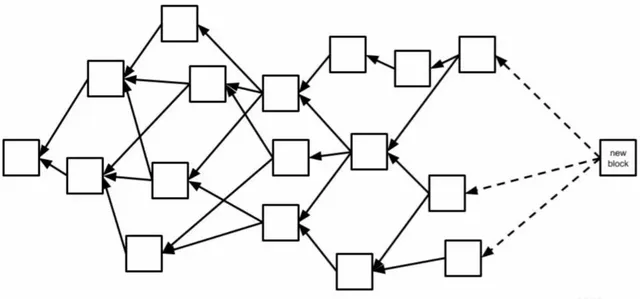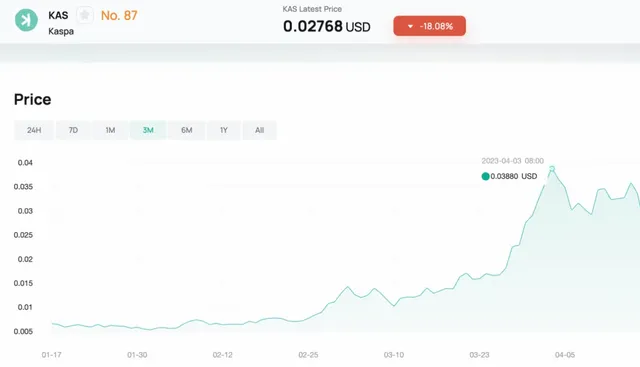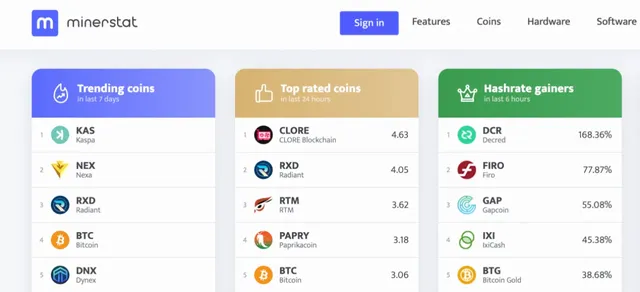CoinEx Academy | Kaspa, a Rising New Star
On April 16, Kaspa released Rust Alpha, which marks a milestone in its development. This new version will significantly improve the overall performance of Kaspa, while also laying the groundwork for more efficient and faster code library development.
What Is Kaspa?
Relying on its BlockDAG (Directed Acyclic Graph) technology, Kaspa is widely regarded as the fastest PoW network. This innovative ledger architecture is the world’s first to support parallel blocks and instant transaction finality. What sets Kaspa apart is its utilization of the PHANTOM protocol, which allows high block rates, eliminates orphan blocks, and maintains a secure PoW environment.

Market data from the CoinEx website shows that Kaspa’s native token KAS has experienced explosive growth since this March, with the KAS price reaching 0.0388 USDT on April 3, a staggering 205% increase compared to the previous period.

Was Kaspa’s sudden surge a coincidence or a necessity? What makes Kaspa stand out? This article aims to analyze Kaspa’s future potential and development opportunities from two perspectives.
Rust Rewrite to Open a New Era
Scalability is one of the most notable features of Kaspa. In November 2021, the Kaspa mainnet was launched, which was written in Golang (also known as Go). Unlike other cryptos with limited block sizes, KAS has an unlimited block size, enabling Kaspa to process more transactions per second (TPS) and making it more efficient and faster.
In July 2022, developers started to rewrite Kaspa in Rust and the Rust Alpha version was officially released this April. Rust’s ownership model and low-level control over memory management make it easier to write concurrent and parallel code, enabling the platform to process more transactions without compromising speed. It is estimated that Rust Alpha could process up to 32 blocks per second (BPS), which is 32 times faster than the previous figure of 1 BPS enabled by Kaspa written in Go. Furthermore, the Rust rewrite enhances Kaspa’s security, scalability, reliability, and maintainability.
Scalability has always been a challenge facing many networks in the crypto ecosystem. Kaspa addresses this issue by increasing the number of blocks generated and confirmed per second. After the Rust rewrite, Kaspa aims to achieve a processing speed of 100 BPS (blocks per second). That means Kaspa would handle massive transactions more smoothly and efficiently in the future, which is quite appealing to developers, users, and enterprises.

The Dark Horse of the Crypto Mining Industry Following Ethereum
Ever since Ethereum switched from PoW to PoS consensus last year, KAS has entered the radar screen of GPU miners and is widely regarded as one of the most profitable tokens for GPU mining. Kaspa leverages the KHeavyHash algorithm and optimizes security and speed based on the PHANTOM protocol, a scalable generalization of the Nakamoto Consensus (Bitcoin consensus). Slow block rates of traditional cryptos lead to wide disparities in mining income, but Kaspa’s fast block rate in the consensus layer narrows the gap, thereby contributing to mining decentralization.
By utilizing BlockDAG technology and optimizing the PoW mining protocol, Kaspa allows blocks to reference multiple previous blocks instead of a single parent block. This approach is superior to single or parallel blockchain models since no blocks are wasted or orphaned in Kaspa. All blocks are published to the ledger, ensuring that no mining capacity is wasted.
With its unique and innovative technology, Kaspa has significantly improved mining performance and gained increasing popularity among miners. According to MinerStat, KAS currently holds the top spot among the trending coins as the most popular PoW crypto.

Kaspa is a pioneer in the emerging field of BlockDAG, with a significant advantage in this innovative technology. Its scalability realizes higher TPS and BPS without compromising security. Since the mainnet launch, KAS has surged, even during the bear market. It’s noteworthy that KAS has yet to experience a bull market in a real sense. In other words, its price may increase by over 50 times during the next bull market.
Following the transition from Go to Rust, Kaspa will start smart contract integration deployment in May, further boosting its performance. In the future, Kaspa will likely become the fastest, most secure, and most scalable decentralized network in history.
*This article does not constitute any investment advice